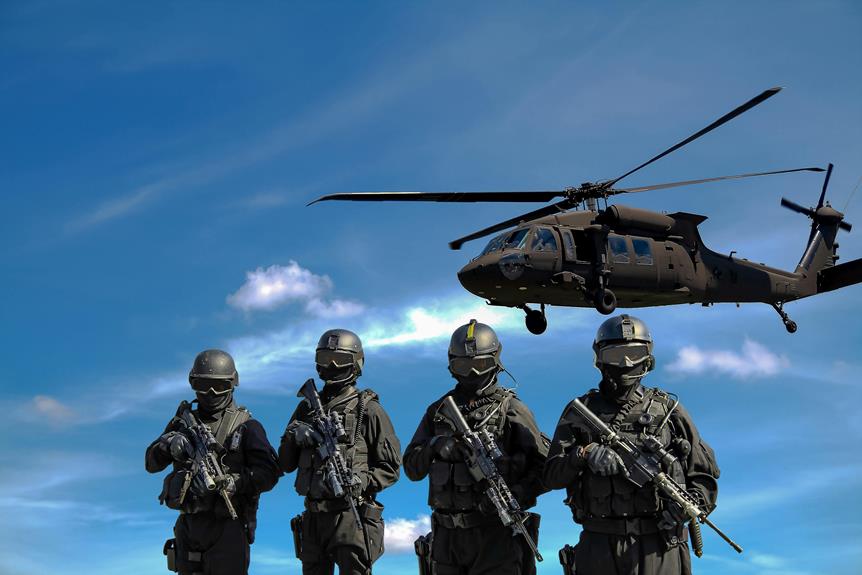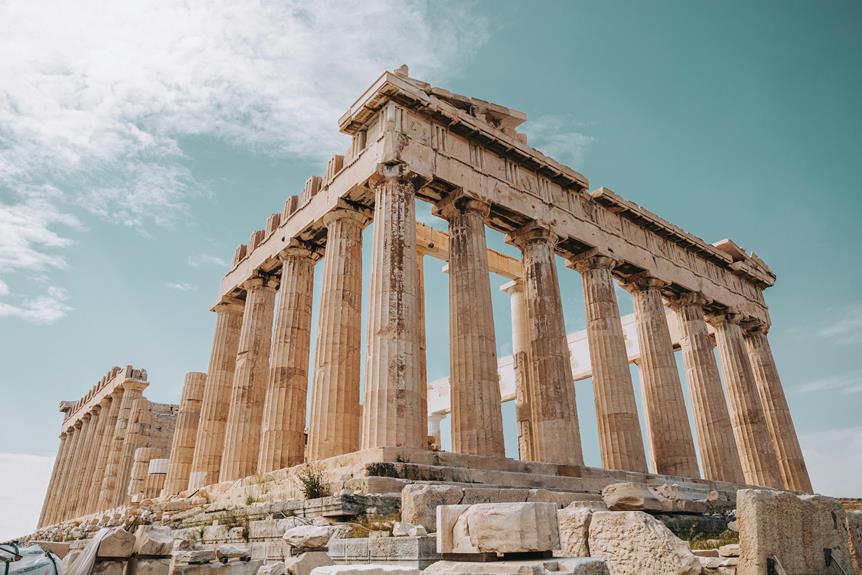Battlefields stand as somber memorials to the conflicts of the past, bearing witness to the bloodshed and sacrifices made in the name of various causes. Each battlefield holds a unique story, a narrative of bravery, tragedy, and resilience. These historical sites offer a glimpse into the tumultuous events that have shaped nations and societies, prompting us to contemplate the human cost of war and the enduring impact it leaves behind. As we explore the significance of battlefields, we unravel the complex tapestry of our shared history, inviting us to contemplate the lessons they hold for the present and the future.
Key Takeaways
- Historical significance and emotional connections.
- Economic benefits for local communities.
- Environmental effects on ecosystems.
- Preservation efforts balancing history and conservation.
- War tourism fostering understanding and remembrance.
Evolution of Battlefield Tactics
The evolution of battlefield tactics throughout history has been a critical aspect of military strategy, shaping the outcomes of conflicts and influencing the course of warfare. Among the various tactics employed, guerrilla warfare tactics have played a significant role in asymmetrical warfare. Guerrilla warfare involves small, mobile groups using ambushes, sabotage, and hit-and-run tactics to wear down a larger and less mobile traditional army. This strategy has been utilized by various groups, from ancient times to modern conflicts, proving its effectiveness in challenging conventional forces.
Strategic retreats also stand out as a key tactic in the evolution of battlefield strategies. Knowing when to retreat strategically can often be as important as knowing when to advance. By withdrawing from a losing battle or position in an organized and planned manner, military leaders can regroup, reassess the situation, and potentially launch a counterattack at a more opportune moment. Strategic retreats have been employed by renowned military commanders throughout history to preserve their forces and live to fight another day.
Iconic Battlefields Throughout History
Examining pivotal engagements on the global stage reveals the enduring significance of iconic battlefields throughout history. These battlefields have witnessed significant events orchestrated by famous generals, shaping the course of nations and civilizations. Let's explore some of the most renowned battlefields that have left a lasting mark on history:
| Battlefield | Location | Key Events |
|---|---|---|
| Thermopylae | Greece | Famous for the stand of the Spartans against the Persians |
| Waterloo | Belgium | Napoleon's final defeat by the British and Prussian forces |
| Gettysburg | United States | Turning point in the American Civil War |
Thermopylae, located in Greece, gained fame for the heroic stand of the Spartans against the Persians, showcasing strategic maneuvers in a narrow pass. Waterloo, situated in Belgium, became the site of Napoleon's final defeat by the British and Prussian forces, orchestrated by famous generals like Wellington and Blucher. Gettysburg, a battlefield in the United States, marked a significant turning point in the American Civil War, where strategic tactics employed by generals like Robert E. Lee and George Meade determined the fate of the nation. These iconic battlefields serve as reminders of the sacrifices made and the strategic brilliance displayed by military leaders throughout history.
Impact of Technology on Modern Battlefields
In the domain of modern warfare, the impact of advancing technology on battlefields has revolutionized military strategies and tactics greatly. One of the most significant advancements is the integration of drones into military operations. Drones, also known as Unmanned Aerial Vehicles (UAVs), have transformed the way battles are fought by providing real-time intelligence, surveillance, and reconnaissance capabilities. They can be used for targeted strikes, eliminating the need for risking human lives on the frontline.
Moreover, cyber warfare has emerged as a critical component of modern battlefields. It involves the use of technology to disrupt an adversary's communication systems, infrastructure, and computer networks. Cyberattacks can cripple an opponent's ability to command and control their forces, giving a significant advantage to those who excel in this digital battlefield.
The combination of drones and cyber warfare has created a new dimension of warfare, where battles are not only fought on the ground but also in the digital domain. This integration of technology has forced militaries around the world to adapt and evolve their strategies to stay ahead in the ever-changing landscape of modern warfare. As technology continues to advance, the impact on modern battlefields will only become more profound, shaping the future of warfare as we understand it.
Cultural Significance of War Sites
As battlefields witness the rapid evolution of technology and warfare strategies, exploring the cultural significance of war sites becomes essential in understanding the historical and emotional impact of conflicts on societies. War sites hold a deep historical significance, serving as tangible reminders of past conflicts, sacrifices, and victories. These locations often evoke strong emotional connections among individuals, ranging from feelings of pride and patriotism to sorrow and reflection.
One of the key aspects of war sites is their ability to foster emotional connections with visitors. People often visit these sites to pay respects to fallen soldiers, connect with their own heritage, or simply to learn about past events that shaped the world. The emotional impact of war sites can be profound, stirring feelings of empathy, gratitude, and even a renewed commitment to peace.
Furthermore, war sites play an important role in historical tourism, attracting visitors from around the world who seek to understand the events that unfolded on these grounds. Historical tourism not only generates economic benefits for local communities but also helps preserve the memory of past conflicts for future generations. By visiting war sites, individuals can gain a deeper appreciation for the sacrifices made by those who fought in wars, fostering a sense of collective memory and understanding.
Environmental Effects of Battlefields
The aftermath of battles and military operations often leaves a lasting impact on the environment, with various ecological consequences that extend far beyond the immediate conflict zone. The ecological impact of battlefields can be profound and long-lasting. One of the most prominent effects is soil contamination from munitions, explosives, and hazardous chemicals used during warfare. These substances can seep into the ground, polluting water sources and disrupting the local ecosystem.
Moreover, the destruction of vegetation and habitats during battles can lead to soil erosion, loss of biodiversity, and disruption of natural processes. Historical battlefields often bear scars from intense fighting, with trenches, craters, and fortifications altering the landscape and hindering ecosystem recovery. The disturbance of land during warfare can also make it susceptible to invasive species, further threatening native flora and fauna.
The historical significance of battlefields adds another layer to the environmental impact. Many of these sites hold cultural and symbolic value, attracting visitors and tourism. However, the influx of tourists can put additional pressure on the fragile ecosystems of these areas, exacerbating environmental degradation. Balancing the preservation of historical sites with the conservation of their natural surroundings presents a complex challenge that requires careful planning and management to safeguard the protection of both cultural and ecological heritage.
Preservation Efforts for Historical Battlefields
Preservation efforts for historical battlefields encompass a multifaceted approach aimed at conserving both the cultural significance and ecological integrity of these sites amidst the challenges posed by their wartime legacies. This involves various strategies and initiatives to make certain that these historically significant locations are maintained for future generations.
Key aspects of preservation efforts for historical battlefields include:
- Battlefield Restoration: Restoration activities involve the physical rehabilitation of the battlefield landscape to reflect its historical appearance. This may include reconstructing trenches, fortifications, and other structures that were present during the conflict. By restoring these elements, the battlefield's historical authenticity is preserved, providing visitors with a more immersive experience and a deeper understanding of the events that transpired.
- Historical Interpretation: Historical interpretation plays an important role in preserving the cultural significance of battlefields. Interpretive programs, such as guided tours, educational exhibits, and signage, help visitors contextualize the historical events that unfolded on the battlefield. Through interpretation, visitors gain insights into the strategies, tactics, and human experiences associated with the conflict, fostering a greater appreciation for the sacrifices made by those involved.
- Ecological Conservation: In addition to preserving the historical aspects of battlefields, conservation efforts are also focused on protecting the natural environment surrounding these sites. Ecologically sensitive practices, such as habitat restoration, invasive species management, and sustainable land use planning, help maintain the biodiversity and ecological balance of the battlefield landscapes. By integrating ecological conservation into preservation efforts, historical battlefields can serve as both educational resources and thriving ecosystems.
Touring and Remembering War Zones
Efficiently exploring the historical significance and impact of war zones through guided tours and commemorative activities forms an essential aspect of preserving collective memory and understanding. War tourism, although controversial due to ethical considerations, provides individuals with an opportunity to witness firsthand the sites where significant events unfolded, fostering a deeper connection to history. These tours often include visits to museums, monuments, and preserved battlefields, allowing visitors to engage with the past in a tangible way.
Memorial ceremonies play a vital role in honoring the sacrifices made by individuals during wartime. These events serve as a platform for remembrance, where communities come together to pay their respects and reflect on the consequences of war. Through rituals, speeches, and moments of silence, participants express gratitude and solidarity, ensuring that the memory of those who perished is preserved for future generations.
To emphasize the emotional impact of war zone visits and memorial ceremonies, the following table illustrates key elements of these experiences:
| War Zone Visits and Memorial Ceremonies | ||||
|---|---|---|---|---|
| Connection to History | Emotional Reflection | Community Unity | Gratitude | Preservation of Memory |
| Witness historical sites firsthand | Reflect on the past | Come together | Honor sacrifices | Protect remembrance |
Frequently Asked Questions
How Do Battlefield Tactics Differ Between Ancient and Modern Warfare?
When comparing ancient tactics to modern strategies in warfare, significant differences emerge.
Ancient tactics often relied on formations, close combat, and siege warfare, while modern strategies focus on technology, maneuver warfare, and precision strikes.
The psychological impact of warfare has evolved as well, with ancient battles emphasizing honor and glory, while modern warfare emphasizes efficiency and achieving objectives.
Technological advancements have revolutionized warfare, introducing drones, cyber warfare, and advanced weaponry, altering the battlefield landscape.
What Is the Significance of Lesser-Known Battlefields in History?
Uncovering forgotten battles holds immense historical significance, shedding light on lesser-known events that have shaped the course of history.
However, preserving these sites poses significant challenges, from environmental impacts to lack of recognition.
Delving into these battlefields not only enriches our understanding of the past but also prompts us to reevaluate the narratives we hold dear.
How Has Technology Influenced Psychological Warfare on Modern Battlefields?
Technology has profoundly impacted psychological warfare on modern battlefields. Cyber warfare and propaganda tactics are now key tools in influencing perceptions and behavior.
Virtual reality allows for immersive experiences that can manipulate psychological responses. Through sophisticated technologies, psychological manipulation has become more targeted and pervasive, blurring the lines between reality and fiction.
These advancements highlight the evolving landscape of warfare and the critical role technology plays in shaping psychological strategies in conflict.
What Cultural Rituals or Practices Surround War Site Memorials?
Memorial ceremonies and remembrance walks play a significant role in honoring the sacrifices made during conflicts. War memorial graffiti and victory parades are additional cultural rituals associated with commemorating war sites. These practices serve as a way for communities to collectively remember and pay respects to those who gave their lives in service.
Through these rituals, the memory of past events is preserved and passed down through generations, fostering a sense of national identity and unity.
Are There Any Innovative Methods for Sustainable Battlefield Preservation?
In the domain of historical preservation, innovative methods for sustainable maintenance are essential for upholding the integrity and significance of cultural memorials.
When considering the impact of technology warfare, psychological influence, and battlefield tactics, it is imperative to explore how ancient versus modern warfare strategies have shaped these sites.
Conclusion
In conclusion, the evolution of battlefield tactics, the cultural significance of war sites, and the impact of technology on modern battlefields all highlight the intricate tapestry of history woven on these hallowed grounds.
As we strive to preserve these sites and remember the sacrifices made, we are reminded of the enduring lessons learned from the conflicts of the past.
The battlefields stand as solemn reminders of the price of war and the resilience of the human spirit.


